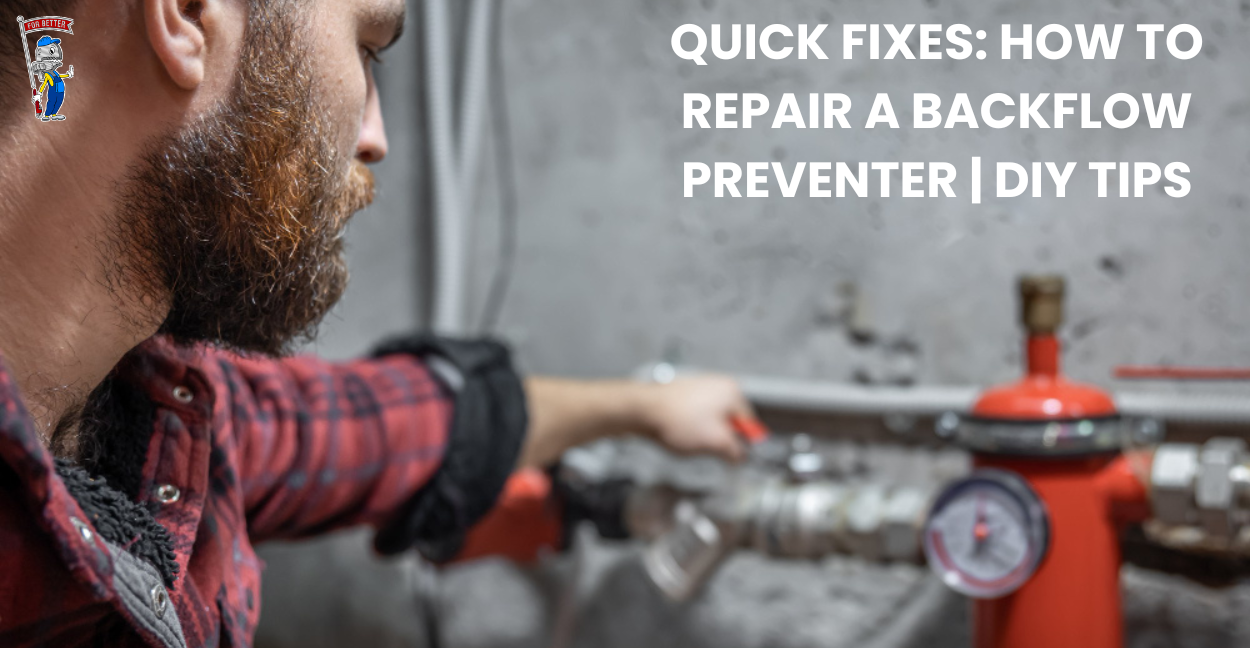A backflow preventer is a crucial component of your plumbing system, designed to keep your drinking water safe from contamination. However, like any mechanical device, backflow preventers can encounter issues over time. In this article, we’ll walk you through the steps to identify and repair common problems with your backflow preventer, ensuring your water remains clean and safe for consumption.
What is a Backflow Preventer?
Before diving into repairs, let’s briefly understand what a backflow preventer does. A backflow preventer is a valve installed in your plumbing system to prevent the reverse flow of contaminated water into the clean water supply. It’s essential for protecting public health and ensuring the integrity of your water supply. If you want to know more about What is Backflow Prevention Device, the Types of Backflow Prevention Devices, and their purpose. You can check out this article: “What is a Backflow Prevention Device? Your Comprehensive Guide!” We have covered everything about the Backflow preventer there.
Step-by-Step Guide on How to Repair a Backflow Preventer
Step 1: Identify the Problem
The first step in repairing a backflow preventer is to identify the issue. Common problems include leaks, reduced water pressure, and malfunctioning valves. Inspect the device carefully, looking for any signs of damage or irregularities.
Step 2: Shut Off the Water Supply
Before attempting any repairs, it’s crucial to shut off the water supply to the backflow preventer. This will prevent any further contamination or damage to your plumbing system.
Step 3: Clean the Device
In many cases, debris or sediment buildup can cause issues with the backflow preventer. Use a brush or cloth to clean the device thoroughly, removing any dirt or debris that may be obstructing the valves or sensors.
Step 4: Replace Faulty Parts
If you’ve identified a specific component that’s causing the problem, such as a damaged valve or sensor, you may need to replace it. Consult the manufacturer’s instructions or seek advice from a professional plumber to ensure you select the correct replacement parts.
Step 5: Test the Device
Once you’ve completed the repairs, it’s essential to test the backflow preventer to ensure it’s functioning correctly. Turn the water supply back on and observe the device for any signs of leaks or malfunctions. Additionally, you may need to perform a backflow prevention test to verify that the device is working as intended.
Step 6: Regular Maintenance
To prevent future issues with your backflow preventer, it’s essential to perform regular maintenance. This includes cleaning the device periodically, checking for leaks or damage, and scheduling professional inspections as needed.
Repairing a backflow preventer may seem daunting, but with the right knowledge and guidance, it can be a straightforward process. By following the steps outlined and staying proactive with maintenance, you can ensure your backflow preventer continues to protect your drinking water for years to come. If you encounter any difficulties or are unsure about making repairs yourself, don’t hesitate to seek assistance from a qualified plumber or technician.
With over a decade of industry experience, our dedicated team is committed to ensuring the purity and integrity of your water systems. We understand the critical role clean and uncontaminated water plays in your daily life, whether at home or in your business. Call us now at Fairfax +1 (703)-250-4200, Arlington+1 (703)-524-1250.
How to Repair Leaking Backflow Preventer
A leaking backflow preventer can be a headache for homeowners but fear not – with the right guidance, you can tackle this issue like a pro. Let’s discuss the steps to diagnose and repair a leaking backflow preventer.
Step 1: Locate the Leak
The first step in repairing a leaking backflow preventer is to locate the source of the leak. Inspect the device carefully, paying close attention to any visible cracks, holes, or signs of corrosion. Leaks can occur at various points on the backflow preventer, including the valves, fittings, and seals.
Step 2: Shut Off the Water Supply
Before attempting any repairs, it’s crucial to shut off the water supply to the backflow preventer. This will prevent any further leakage and minimize the risk of water damage to your property.
Step 3: Replace Damaged Components
Once you’ve identified the source of the leak, you’ll need to replace the damaged components. This may involve replacing seals, valves, or other parts of the backflow preventer. Be sure to use high-quality replacement parts that are compatible with your specific model of backflow preventer.
Step 4: Tighten Loose Fittings
In some cases, leaks may be caused by loose fittings or connections on the backflow preventer. Use a wrench or pliers to tighten any loose fittings, being careful not to over-tighten and damage the threads.
Step 5: Test the Device
After making the necessary repairs, it’s essential to test the backflow preventer to ensure the leak has been resolved. Turn the water supply back on and observe the device for any signs of leakage. Additionally, you may need to perform a backflow prevention test to verify that the device is functioning correctly.
Step 6: Schedule Regular Maintenance
To prevent future leaks and ensure the continued functionality of your backflow preventer, it’s essential to schedule regular maintenance. This includes inspecting the device for signs of wear or damage, cleaning it periodically, and replacing any worn-out components as needed.
Common Causes of Backflow Preventer Damage
Several factors can contribute to the deterioration and malfunction of backflow preventers. These include age, corrosion, wear and tear, improper installation, and exposure to extreme weather conditions. Additionally, backflow preventers may be damaged by debris or sediment buildup within the system.
Signs That Your Backflow Preventer Needs Repair
Recognizing the signs of a malfunctioning backflow preventer is crucial for prompt repair. Some common indicators include reduced water pressure, leaks around the device, unusual noises, and visible signs of damage or corrosion. If you notice any of these symptoms, it’s essential to address them promptly to prevent further issues.
FAQs
Can I repair a backflow preventer myself?
While some minor repairs can be DIY. You can follow our detailed step-by-step guide above to learn how to DIY. However, if there are major repairs then it’s best to seek professional help for complex issues to ensure proper repair and safety.
How often should I inspect my backflow preventer?
It’s recommended to schedule annual inspections by a qualified professional to catch any potential issues early.
How long does it take to repair a backflow preventer?
The time required for repairs can vary depending on the extent of the damage and the availability of replacement parts. Minor repairs may be completed in a few hours, while more extensive repairs could take longer.
What are the consequences of not repairing a malfunctioning backflow preventer?
Failure to repair a malfunctioning backflow preventer can result in contaminated drinking water, which poses serious health risks to consumers.



